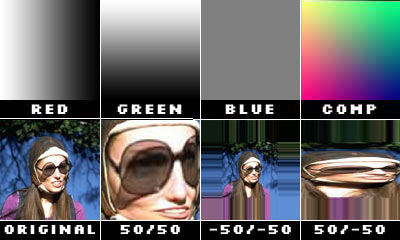Technical Slop
Navigation
Displace
Considerations
Solid
Channels
Circle Grads
Gradients
PSD
Curve It
Tweakables
Scans
Broken China
Bulge
Math 1
Math 2
Heat Waves
Reflection Maps
Power Distort
Other
Cannify
Extrude
Whispies
AMP
Brush Making
Picking Colours
13 Revisited
Levels
Pixel Shuffle
UVW 2
Pui Pui
Light Rig
The CubesYou've seen what some gradients do horizontally and vertically; you know that channel one is horizontal and that channel two is vertical. You have all you need to figure out what's about to follow. For a lot of parlour tricks, I start out with one of 3 basic cubes. These serve as a base or starting point for a lot of the stuff that I do with Displace. I keep them tucked away on my harddrive and open them for when I'm in the mood to explore some basic ideas. They serve me well. I highly recommend that you make your own and fiddle with them. Zoom CubeThis first one is what I call the Zoom Cube. I'm very affectionate with the Zoom Cube.
I call it the Zoom Cube because it expands, or "zooms", with two positive percentages. A lot of fun Squish Factor thing can be done with this cube. Later on, I'll be using this one for some "advanced" techniques.
Skew CubeThis one I call Skew Cube. Actually, this is only one of several Skew Cubes. This one does come in several flavors, but I generally use this particular one.
When you get to playing with this one, inverting the various channels and mixing up the positive/negative values, some interesting things happen. Notice the final example of 50/-50 in particular.
Rotate CubeThis is another one of my favorite cubes. While it's not a true rotation of the target, it does rotate to an extent.
Along with the Zoom Cube, I'll be using this one for some "advanced" techniques. Notice the final example of 50/-50. Neat, eh? Do you have what it takes to figure out what is going on? I hope so.
As an end to all of this, I really do hope you play with various gradients in the two different channels. I also hope you play with positive/negative values. While I don't expect you to totally predict the results, I do expect you have a sneaky suspicion. You might even want to take notes. Seriously. Remember: there are different kinds of gradients other and Linear and you can put the Gradient tool in different kinds of modes. It's times like this when it really counts - play.fiddle.learn *Note: While the above cubes are good and all, my examples aren't exactly right. Read about my Vicious Lie! |


